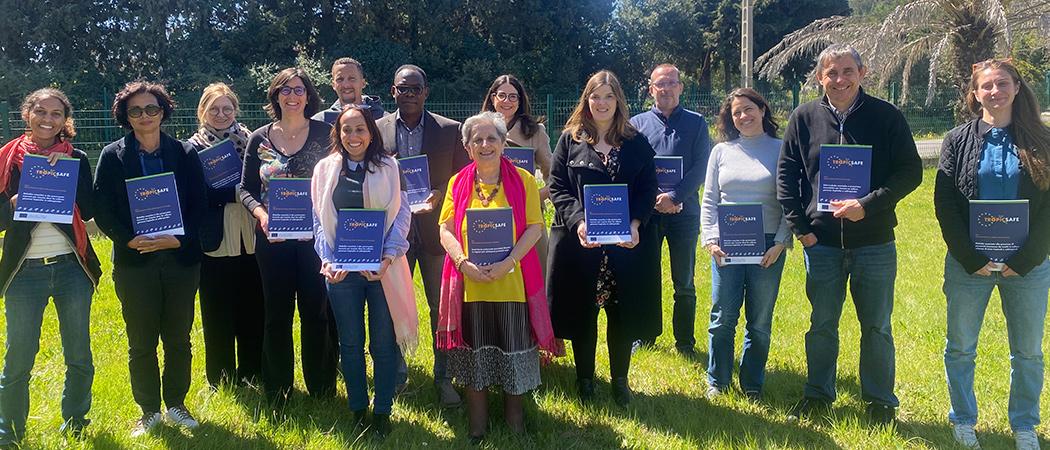TROPICSAFE paves the way for better management of coconut lethal yellowing, grapevine yellows and huanglongbing

TROPICSAFE consortium in Corsica
For five years, the TROPICSAFE project, funded by the Horizon 2020 programme and coordinated by Prof. Assunta Bertaccini (University of Bologna, Italy), studied three economically important insect-borne prokaryote-associated diseases of perennial crops grown in tropical and subtropical areas. Diverse ‘Candidatus Phytoplasma’ species associated with lethal yellowing in coconut palms and yellows in grapevine, and ‘Ca. Liberibacter’ species associated with “huanglongbing” in citrus were detected and studied.
For their effective, and sustainable management, important knowledge gaps were filled working in Africa, America, the Caribbean, and Europe. Monitoring and developing specific diagnostic methods allowed the identification of the different bacteria associated with these diseases in the ecosystems studied. New insect vectors and alternative host plant species were also identified. The knowledge acquired will allow environmentally friendly disease management reducing insecticide treatments. The studies carried out open the way to innovative management methodologies.
The surveys in Africa resulted in the identification of ‘Ca. P. palmicola’ strains in coconut palms in Ghana and Mozambique. In Ghana, alternative plant host species and putative insect vectors were identified and a new LAMP diagnostic assay was applied. Evaluation of four dwarf coconut varieties showed potential to be used in rehabilitating the coconut industry.
In Cuba, Jamaica, and Mexico ‘Ca. P. palmae’ was detected in coconut and other palms, and Haplaxius crudus was confirmed as insect vector in Mexico and Cuba. In Jamaica, Stachytarpheta jamaicensis and Cleome rutidosperma were harbouring the phytoplasma, while H. crudus and Oecleus mackaspringii are possible insect vectors.
In Mexico, alternative host plant species were identified, some of which harbour H. crudus nymphs. Different palm ecotypes are under field evaluation for resistance using specific molecular markers. Resistant germplasm from Mexico has been transferred as in vitro plants to Cuba and Jamaica to compare its performance in diverse geographic areas. A qPCR multiplex methodology, distinguishing between 16SrIV-A and 16SrIV-D phytoplasmas, was developed.
In South Africa, ‘Ca. P. asteris’ was detected in Mesembryanthemum crystallinum, Protea cynaroides, and Raphanus sativus, and in the insects Aconurella prolixa and Exitianus sp. The most abundant insect in vineyards was Mgenia fuscovaria. A seasonal management plan has been developed including recommendations for leafhopper monitoring, weed control, sanitation, and chemical control. Plant-derived antimicrobial peptides were prepared and preliminary screenings against phytoplasma-containing colonies were performed.
In Chile, eight alternative host plants for the ‘Ca. P. pruni’ strain were detected (16SrIII-J), and six insect vectors or potential vectors were identified. In Italy, besides “bois noir” and “flavescence dorée” a number of other phytoplasmas were detected in vineyards infected with grapevine yellows. An experimental vineyard obtained with the F1 crossing population between genotypes with differential susceptibility to grapevine yellows was infected using insect vectors. Genotyping of the individuals was carried out on 300 biotypes, and phenotyping is ongoing in the field to merge the data for the identification of genetic traits putatively associated with grapevine yellow resistance.
A new ELISA kit was developed targeting “flavescence dorée” phytoplasmas. To assess the performances, a comparative analysis of the ELISA versus qPCR was carried out. Antisera produced using phytoplasma colonies of ‘Ca. P. asteris’ were able to detect the agent in colonies and in periwinkle samples by an immunoflourescence assay.
Surveys in citrus orchards confirmed the presence of ‘Ca. L. africanus’ in South Africa and ‘Ca. L. asiaticus’ in Guadeloupe, Jamaica, Mexico, and Cuba. None of these bacteria was detected in the surveys carried out in five citrus-growing regions of Chile or in Spain. Surveys did not result in the detection of alternative insect or plant host species.
The presence of the vectors Diaphorina citri in Cuba, Mexico, and Guadeloupe, and Trioza erytreae in South Africa and Spain was confirmed. Since native parasitoids of T. erytreae were not identified in Spain, Tamarixia dryi from South Africa was introduced, showing good dispersion and parasitism efficacy.
A survey in the main citrus-producing areas of Cuba confirmed D. citri presence throughout the island with a seasonal trend connected to management strategies, irrigation or rains. Elimination of the symptomatic trees at a regional scale resulted in the best management strategy. The efficacy of kaolin against D. citri kept the infestation level very low for two years.
In Guadeloupe, despite the relatively low abundance of D. citri in some orchards under an IPM program, the disease levels and mortality of the citrus trees were very high. Different combinations of rootstocks/varieties were selected and, after four years from plantation, all the trees became infected although they were asymptomatic and had fruits. The relationship between “huanglongbing” susceptibility and anatomical, physiological, and metabolomic traits with a special focus on the potential impact of polyploidy on disease tolerance was determined.
A PCR assay to detect ‘Ca. L. africanus’ and its local subspecies was developed in South Africa.




 A unique international forum for public research organisations and companies to connect their external engagement with strategic interests around their R&D system.
A unique international forum for public research organisations and companies to connect their external engagement with strategic interests around their R&D system.